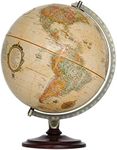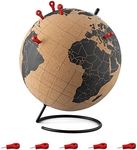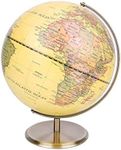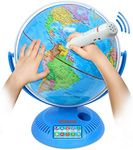Buying Guide for the Best World Globes
Choosing the right world globe can be a fun and educational experience. Whether you're looking for a globe for educational purposes, decoration, or as a gift, there are several key specifications to consider. Understanding these specifications will help you make an informed decision and select a globe that best fits your needs.SizeThe size of a globe is measured by its diameter, which can range from small desktop globes to large floor-standing models. A smaller globe (under 12 inches) is ideal for personal use or small spaces, while a medium-sized globe (12-20 inches) is suitable for educational purposes and general use. Larger globes (over 20 inches) are often used for display and can make a striking decorative piece. Consider where you plan to place the globe and how much detail you want to see when choosing the size.
MaterialGlobes can be made from various materials, including plastic, wood, metal, and glass. Plastic globes are lightweight and durable, making them suitable for children and frequent handling. Wooden and metal globes offer a more classic and elegant look, perfect for home or office decor. Glass globes are often more delicate and can be used as decorative pieces. Think about the intended use and the aesthetic you prefer when selecting the material.
Map TypeThe map type on a globe can vary, including political, physical, and thematic maps. Political globes show country borders and cities, making them great for learning geography. Physical globes display natural features like mountains, rivers, and oceans, ideal for understanding Earth's physical landscape. Thematic globes can focus on specific topics like climate, population, or historical events. Choose a map type based on what you want to learn or display.
IlluminationSome globes come with built-in illumination, allowing them to light up from within. Illuminated globes can serve as nightlights and add a unique visual appeal, highlighting different features when lit. Non-illuminated globes are more traditional and may be preferred for a classic look. Consider if you want the added functionality and aesthetic of an illuminated globe.
Stand and MountThe stand and mount of a globe can affect its stability and appearance. Common types include simple bases, tripod stands, and full floor stands. A sturdy base is essential for smaller globes, while larger globes may benefit from more elaborate stands for better support and visual impact. Think about where you will place the globe and how much space you have when choosing the stand and mount.
Rotational AxisGlobes can have different types of rotational axes, allowing them to spin in various ways. Some globes rotate on a single axis, mimicking Earth's rotation, while others can tilt and spin freely. A globe with a single axis is great for educational purposes, helping to understand Earth's rotation and axis. Freely spinning globes can be more interactive and fun to use. Consider how you want to interact with the globe when choosing the rotational axis.

















